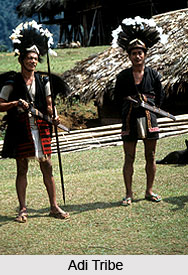 Tribes of Arunachal Pradesh form the major part of demography of Arunachal Pradesh. It is one of the largest states of north east which provides habitation to at least 20 tribal groups who are scattered in the huge state. The tribal people of this region are adept in making baskets, smithy work, weaving, pottery, wood carving and painting.
Tribes of Arunachal Pradesh form the major part of demography of Arunachal Pradesh. It is one of the largest states of north east which provides habitation to at least 20 tribal groups who are scattered in the huge state. The tribal people of this region are adept in making baskets, smithy work, weaving, pottery, wood carving and painting.
The Tribes of Arunachal Pradesh
Tribes of Arunachal Pradesh largely include the tribes of Adis, Apatanis, Buguns, Hrusso, Singphos, Mishmis, Monpas, Nyishi, Sherdukpens, Tagins, Khamtis, Wanchos, Noctes, Yobin, Khambas, Membas, Aka, Miji, Bori, Bokar, Galo etc. Some of them have been detailed below:
Adi Tribe: The Adis have two main divisions, the Bogum and Bomis, and under each there are a number of sub-tribes. By nature, the Adis are democratic and organized. Their village council is called Kebang. Their villages are usually situated on the spurs of hills. Adi women are very good weavers.
 Apatani Tribe: The Apatanis are settled agriculturists. They inhabit the valley around Ziro -the headquarters of Lower Subansiri district. They are good cultivators and practice both wet and terrace cultivation.
Apatani Tribe: The Apatanis are settled agriculturists. They inhabit the valley around Ziro -the headquarters of Lower Subansiri district. They are good cultivators and practice both wet and terrace cultivation.
Bugun Tribe: The Buguns are also agriculturists and perform a number of rites and ceremonies for their welfare. By nature, they are gentle, hospitable and affectionate people.
Hrusso Tribe: They were related with the Ahom Kings. They have a custom of painting their face with black marks. The Hrusso is mainly involved in the trades of cloth, blankets, swords, etc.
Singpho Tribe: The Singphos reside on the banks of Tengapani and Noa Dehang rivers. They are agriculturists and expert blacksmiths. The Singpho women are good weavers.
Mishmi Tribe: Mishmis form the bulk of the population of Lohit, Upper Dibang Valley and Lower Dibang Valley districts. They are divided into three main groups including Idus or Chulikatas, Digarus or Taroan and Mijus or Kaman. Agriculture is the main occupation of Mishmis. However, they are also good traders. The chief items of trade are deer mask, wild medicinal plants, animal skins etc.
Nyishi Tribe: The Nyishis are the largest groups of people inhabiting the major part of Lower Subansiri district. The men of this tribe keep their hair long and tie it in a knot just above the forehead. They wear cane bands around the waist. This tribe believes that after death, the spirit of a dead travels to the "village of the ancestors".
Sherdukpen Tribe: The Sherdukpens are a small tribe and their religion is a blend of Mahayana Buddhism and tribal magic-religious beliefs. They are good agriculturist but trade is their main interest.
Tagin Tribe: The Tagins are main inhabitant of Upper Subansiri district. Agriculture is their main occupation.
Khamti Tribe: It is believed that the Khamtis have migrated from the Shan states of Burma. They are Buddhists (Hinayana cult) by religion and bury the dead in a coffin.
Wancho Tribe: The western part of Tirap district, bordering Nagaland, is inhabited by the Wanchos. The society of this tribe is divided into four classes including Wanghams, Wangpana, Wangaue and Wangaas. The law and order of the society is maintained by a village council. Tattooing is a social custom among them.
Nocte Tribe: The Noctes are settled in the central part of Tirap to the east of the Wanchos. They profess Vaishnavism. The tribe is noted as salt producers.
Yobin Tribe: The Yobin is a small group of people inhabiting the remote easternmost corner of the Tirap district. They are also called Lisus.
Khamba and Memba Tribes: The Khambas and Membas inhabit the northern part of West Siang. They are Buddhist by religion. Agricultural is their main occupation.
















